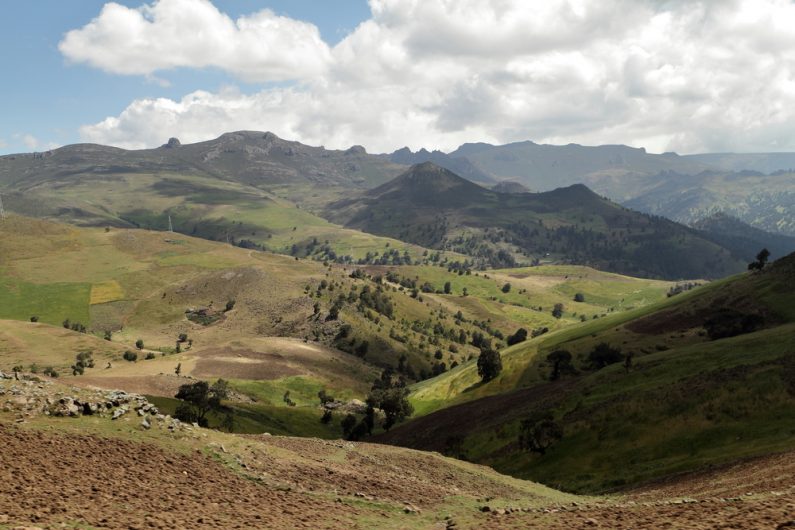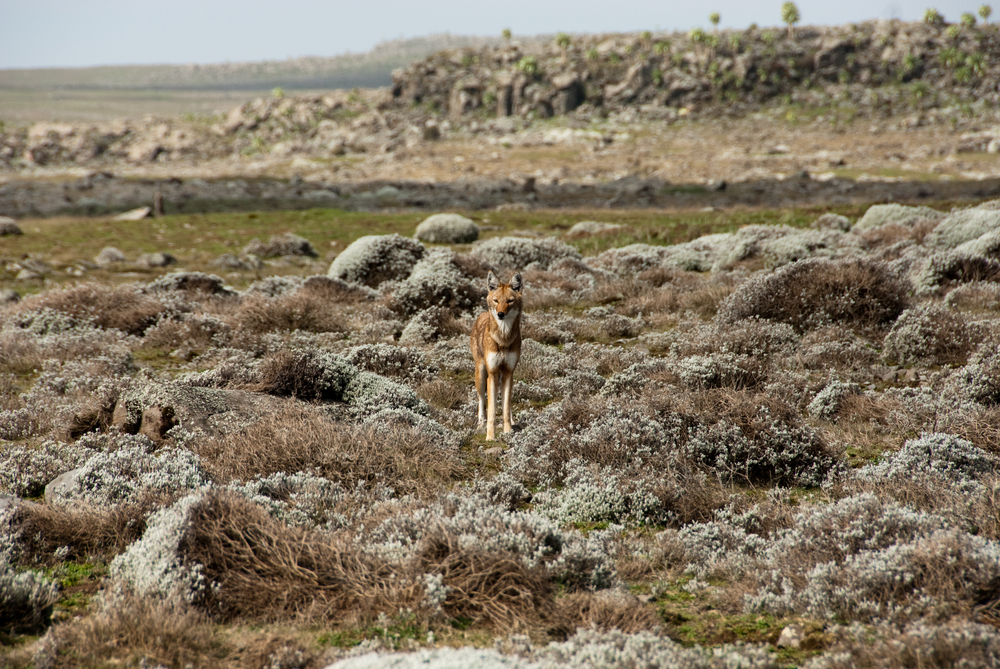The Bale Mountains National Park established primarily for the protection of the Mountain Nyala and Ethiopian Wolf, and other features including spectacular scenery, an extensive Afro-alpine plateau and moist highland forest. It is an ideal home for the endemic mammal species of Mountain Nyala, Ethiopian Wolf or Simen Wolf and Menelik’s, Lions, Bohor Reed Buck, Greater and Lesser Kudu, Leopard; Wart Hog are some of the other few mammals can be seen in the park.
The widely seen hygiene Abyssinica and Juniper trees dominated the park gives a suitable environment for birds, Thick Billed Roven (endemic) Rogetis Rail(endemic), Wattled lbis (endemic) and more others. Mount Tulu diimtu, the second highest pick in Ethiopia (4373ms) asl beautifies at the back ground. The mountain is surrounded by forest belt and escarpments which is an ideal spot for trekkers.
Species recorded: 77 mammals and 260 birds
Charismatic species: Mountain Nyala
Location: the park is located south-east of Addis Ababa at the coordinate between N7000’and E39045’. The area is within an altitude range of 1500-4377m asl. The Head Quarter is situated at 400km from Addis near Dinsho town in Bale zone.
Rainy season: is followed by a four month dry season from November to February. Rainfall in the area is characterized by one –eight-month rainy season, with greater bulk of rain falling in April and the August to October. This means that from May-July, there are showers, usually in the afternoon. The area receives up to 1200mm precipitation annually.
Temperature: as to be expected the temperature falls with increasing altitude. The lowest temperatures occur at night in the clear skies of the dry season and the highest temperatures during the day of the same season. The lowest temperature that has been recorded in the mountains is-150c at night, with the highest recorded temperature 260c. In contrast, the rainy season is warmer.
Ecological zone: South east highland
Vegetation types: Afro-alpine moorland, heather, woodland, Gaysay grassland, and Herenna forest. Each of these zones has their own characteristic flora and fauna. These vegetation types are primarily demarcated by altitude.
Major wildlife species of the park: the park harbors diverse flora and fauna and center for endemic, including amphibian.
The widely seen hygiene Abyssinica and Juniper trees dominated the park gives a suitable environment for birds, Thick Billed Roven (endemic) Rogetis Rail(endemic), Wattled lbis (endemic) and more others. Mount Tulu diimtu, the second highest pick in Ethiopia (4373ms) asl beautifies at the back ground. The mountain is surrounded by forest belt and escarpments which is an ideal spot for trekkers.
Species recorded: 77 mammals and 260 birds
Charismatic species: Mountain Nyala
Location: the park is located south-east of Addis Ababa at the coordinate between N7000’and E39045’. The area is within an altitude range of 1500-4377m asl. The Head Quarter is situated at 400km from Addis near Dinsho town in Bale zone.
Rainy season: is followed by a four month dry season from November to February. Rainfall in the area is characterized by one –eight-month rainy season, with greater bulk of rain falling in April and the August to October. This means that from May-July, there are showers, usually in the afternoon. The area receives up to 1200mm precipitation annually.
Temperature: as to be expected the temperature falls with increasing altitude. The lowest temperatures occur at night in the clear skies of the dry season and the highest temperatures during the day of the same season. The lowest temperature that has been recorded in the mountains is-150c at night, with the highest recorded temperature 260c. In contrast, the rainy season is warmer.
Ecological zone: South east highland
Vegetation types: Afro-alpine moorland, heather, woodland, Gaysay grassland, and Herenna forest. Each of these zones has their own characteristic flora and fauna. These vegetation types are primarily demarcated by altitude.
Major wildlife species of the park: the park harbors diverse flora and fauna and center for endemic, including amphibian.

Fauna: Mountain Nyala, menelike’s , Ethiopian Wolf, Bohor Reedbuck, and common(grey) Duiker, Common Jackal, Several Cat, Leopard, Klipspringer, Warthog, Rodents and birds.
Endemic mammals: include Mountain Nyala, Stack’s hare, Ethiopian Wolf, Bale monkey, Giant molerat, Lovat’s mouse, Nikolaus mouse, Mahomet’s mouse, White-footed rat, White-tailed rat, Grey-tailed rat, Blick’s grass rat, Scott’e-hairy bat and four species of shrews such as crocidura Bileyi, crocidura bottegoides, Crocidura harenna and Crocidura thalia.
Endemic birds: include Abyssinian catbird, ABYssinan Longelaw, Yellow-fronted parrot, spot-breasted plover, Black-headed siskin and Golden-backed woodpecker.
Other birds: once used to be endemic include Watteld ibis, Blue-winged goose, Rouget’s rail, white-collared pigeon, Black-winged lovebirds, Banded barber, white-winged cliff-chat, White-backed black tit, Back-headed forest oriole and Thick-billed raven.
Flora: most notable are Giant lobelias, Kniphofia, Helichrysum spleddum, Hypericum revolutum, Hagenia abyssinica/kosso and Juniperus procera.
Major physical/ geological features: pronounced by mountain formations, extensive plateau, and valley and lava outpourings. Over forty streams arise within the park. These join to form four majio rivers, the Webe Shebelle, the Web (leading to Genale and Juba rivers), the Wemel and Dumal Rivers. Alpine lakes are also characteristics features on the Senetti plateau.
Threats to the park: these include expansion of high-altitude settlement and subsistence agriculture and over grazing of highland pasture.
Endemic mammals: include Mountain Nyala, Stack’s hare, Ethiopian Wolf, Bale monkey, Giant molerat, Lovat’s mouse, Nikolaus mouse, Mahomet’s mouse, White-footed rat, White-tailed rat, Grey-tailed rat, Blick’s grass rat, Scott’e-hairy bat and four species of shrews such as crocidura Bileyi, crocidura bottegoides, Crocidura harenna and Crocidura thalia.
Endemic birds: include Abyssinian catbird, ABYssinan Longelaw, Yellow-fronted parrot, spot-breasted plover, Black-headed siskin and Golden-backed woodpecker.
Other birds: once used to be endemic include Watteld ibis, Blue-winged goose, Rouget’s rail, white-collared pigeon, Black-winged lovebirds, Banded barber, white-winged cliff-chat, White-backed black tit, Back-headed forest oriole and Thick-billed raven.
Flora: most notable are Giant lobelias, Kniphofia, Helichrysum spleddum, Hypericum revolutum, Hagenia abyssinica/kosso and Juniperus procera.
Major physical/ geological features: pronounced by mountain formations, extensive plateau, and valley and lava outpourings. Over forty streams arise within the park. These join to form four majio rivers, the Webe Shebelle, the Web (leading to Genale and Juba rivers), the Wemel and Dumal Rivers. Alpine lakes are also characteristics features on the Senetti plateau.
Threats to the park: these include expansion of high-altitude settlement and subsistence agriculture and over grazing of highland pasture.

Places to visit/Things to do:
- Dinsho Hillis: Nature trail designated toward the hill top along the trail is a pleasant to walk for the massive Hagenia and Juniperus trees, the sightings of Mountain Nyala, Menelik’s bushbuck, Warthogs and Bohor Reedbuck. In the evenings, the song of Abyssinian catbird can often be heard. The top over the Gaysay valley are spectacular. The museum offers information on the area and displays an interesting collection.
- The Gaysay valley: it is the northern-most area of the park. it is an area of grassland, shrub, swamp and river. It is an area good for sighting pack of wolves, bohor reedbuck, Warthog, Mountain Nyala, Menelik’s bushbuck, and birds like Harries, Augur buzzard, Rouget’s rail and Abyssinian longclaw. Here Web River flows through a deep and spectacular gorge.
- Senetti Plateau: an extensive plateau where Tullu Deemtu is found. Warm clothes and waterproof Jacket are required as it can be chilly as a result of a strong wind blow. Ethiopian wolves, Rodents, Giant molerat, and Wattles cranes can be seen. Another magnificent sighting on the plateau is its pigmented alpine lakes. The summit of Tullu Deemtu 4377m is accessible by road, and from this top the full extent of the Arroalpine ecosystem, including Herenna escarpment can be clearly observed.
- Herenna forest: it is ca be reached through a road traverses Sanetti plateau. The larger trees include Podocarps, figs, wild stocks of coffee and Schefflera forming closed canopy. The best way to visit this is to camp in Katcha. A portion of the steeper slopes are covered with mountain bamboo. It is the beast places for viewing Guereza, Common baboons, Warthogs, Common bushbuck, Giant forest hog, bush pigs, and Bale monkey, several cats Genets, Civets, Porcupines and Hyenas. Abyssinan Hornbill, black-wing Lovebird, blak-head forst oriole, ellow fronted parrot and Narina’s trogo are some birds can be seen. The forest also attracts a large number of migrant birds including Palaeartic warblers.
- Web valley: the route is so scenic with best place for wolf watching, and to see rock hyrax and Starck’s hare and the Golden eagle hunting.
- Trout fishing: tow species of trout rainbow and brown were introduced in the Danka and Web Rivers, their original stock came Kenya. Permits for fishing in Web River can be purchased from the park. Contacting a fishing guide at Dinsho is advised to known best and time of day to fish.
- Trekking: the park also the best trekking in Ethiopia.
- Outside the park: Sof omar caves the river gorge is spectacular for its depth and for the regular limestone cliffs. Lesser kudu, Greater kudu, Dikdik and Salvadori’s serin can be seen.
- Webe Shebelle gorge: the southern most population of Galada baboon can be seen. The river is also waiting operation to start in the future.
- Dodola- Adaba: it is best organized ecotourism in the country. It is an excellent place for trekkers and hikers. There is a series of five mountains joined by trails for trekking.










